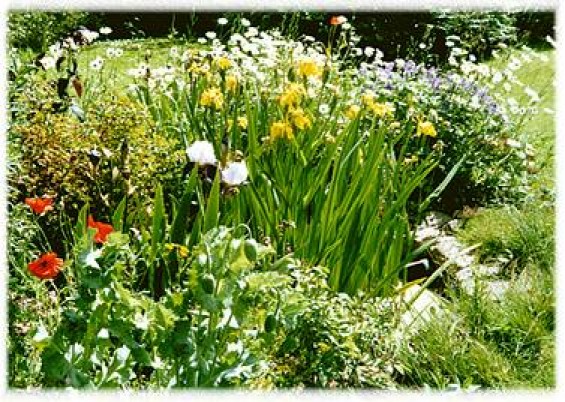I have been thinking about my garden’s pros and cons and whether it suits me given my current limitations, having been ill and then not been fit for 15 years. It’s a high-maintenance flowerful wildlife-friendly country garden. What made me think more than usual about it was the upcoming cost of putting in a new fence, now that my hedge has been decimated (I wanted more of a view and needed to thin them anyway) and the lovely old oak picket fence has capsized and collapsed, needing a new stock fence to keep the deer out. I’ve had a quote for £750.. so I am pausing for breath (and another quote) before taking the plunge, given the investment. Ideally, I would have chosen a garden easier to maintain, but I loved it and the house so much!
Here’s a list of things to think about when you go house and garden-hunting:
1. Maintenance – time or money?
How much time and energy have you got to maintain your new garden? If you are lusting after a garden too big for you to manage, can you afford a gardener?
a) Gardening costs
You may be able to get someone who is retired and offers basic gardening, and doesn’t charge a lot, (£6.50-£9.50 an hour) but for expert gardeners, with some training and a gardening business, the going rate is £15-£30 an hour. The former will need a bit of supervision if you are a keen gardener who grows a lot of different and less usual plants, if you want to hang on to them.
Don’t forget one-off services to get to grips with any major features/plants you may have. I have hedges round 2 sides of my garden, one of which, as the next door garden is down a big slope from mine, is very high on the neighbour’s side, and needs professional help to cut. This costs me £180 a year. In between I used someone who charged £9 an hour and must have paid £1080 a year in total to get the garden maintained – quite an outlay.
b) Time
If you haven’t got the money, have you got the time? My 1/3 acre garden with a lot of lawn, hedges on 2 sides and assorted shrubs, veg and perennials takes 3 hours a week to maintain in the spring and summer, less in August when the grass stops growing, 2 hours Sept/Oct then a break in late November until mid-February. That’s not counting the gardening I do myself, which is to grow things, especially vegetables, from seed, water pots and vegetables in summer, and mooch around the garden cutting things back with a pair of secateurs. (I’m not timing these as I enjoy them.)

Lawns will take 2-3 hours per acre to mow, I have heard say; mine takes 1.5 hours for a bit less than a third of an acre, including strimming the edges. This is included in the maintenance time given above.
c) Features
Consider the features in the garden you are looking at, in the light of the above.

Boundaries: Fences/hedges/walls
- Walls generally need little maintenance if sound, but if old may need repointing, ie the mortar replacing/topping up
- Fences (if sound) need to be retreated or painted every few years.
- Hedges are great for wildlife and interest, however they need to be cut at least once a year. Look up the species and find out how often that species needs cutting back. Leylandii are the quickest-growing and greediest with water needs, and should be avoided. Yew grows the slowest.
Surfaces
- Stone and brick will last well without much attention, though ideally stone should be cleaned, especially if in a shady spot where algae can form and make it slippery. You could hire a machine for this??
- Decking needs a yearly clean to stop algae forming, unless it’s artificial decking (though this may need a clean less often).
- Concrete slabs need cleaning when they get dirty which happens in sun as well as shade
- Gravel and the gaps between slabs or stones or bricks will need weeding anywhere you don’t want plants growing through it. Yes, even if there is landscaping material underneath, though that may keep them back a bit!
d) Planting
Can you maintain the borders in their current state and if not, do you have the energy and will to change them?
- Bedding need to be replanted several times a year as well as weeding and watering
- Perennials do not need watering once established, and if close together, less weeding, but do need dividing every 2-4 years depending on what they are
- Shrubs need pruning as do roses, every year, but need far less attention than herbaceous plants
- Trees need even less attention unless very old and about to drop a branch, but they will need pruning to shape every few years, depending on how pretty you want them, and to keep out the dead wood
- Vegetables are the most intensive but also I think most satisfying as you can grow them and eat them in one season
There’s a lot more I could write here but this is enough for one sitting. May you find the garden that best suits you!
